Wallet recovery phrases, also known as seed phrases, are critical components in the management of cryptocurrency wallets, consisting of 12 to 24 randomly generated words that enable users to recover access to their digital assets. This article explores the functionality, generation process, and security implications of wallet recovery phrases, emphasizing their importance in preventing the irreversible loss of funds due to device failure or forgotten passwords. It also outlines best practices for securely managing these phrases, the risks associated with their loss, and the variations in recovery phrase formats across different cryptocurrencies. Understanding these aspects is essential for users to safeguard their investments and ensure seamless access to their wallets.

What are Wallet Recovery Phrases?
Wallet recovery phrases, also known as seed phrases, are a series of words that allow users to recover access to their cryptocurrency wallets. These phrases typically consist of 12 to 24 randomly generated words that serve as a backup for the wallet’s private keys. The significance of wallet recovery phrases lies in their ability to restore access to funds in case of device loss, theft, or software failure, ensuring that users can regain control over their digital assets.
How do Wallet Recovery Phrases function in cryptocurrency wallets?
Wallet recovery phrases function as a secure method for restoring access to cryptocurrency wallets. These phrases, typically consisting of 12 to 24 words, are generated during the wallet setup and serve as a backup for the private keys associated with the wallet. If a user loses access to their wallet due to device failure or forgotten passwords, they can input the recovery phrase into a compatible wallet application to regain access to their funds. This mechanism relies on the BIP39 standard, which ensures that the recovery phrase can be used across different wallets that support this protocol, thus providing a universal solution for wallet recovery.
What is the process of generating a Wallet Recovery Phrase?
The process of generating a Wallet Recovery Phrase involves creating a sequence of words that serves as a backup for accessing a cryptocurrency wallet. This phrase is typically generated using a secure random number generator that produces a series of entropy, which is then converted into a human-readable format consisting of 12 to 24 words. The words are selected from a predefined list known as the BIP39 word list, ensuring that the phrase is both unique and easy to remember. This method is standardized, making it compatible across various wallets and platforms, thereby enhancing the security and accessibility of digital assets.
How do Wallet Recovery Phrases ensure security for users?
Wallet recovery phrases ensure security for users by providing a method to restore access to their cryptocurrency wallets in case of loss or theft. These phrases, typically consisting of 12 to 24 randomly generated words, serve as a backup that can regenerate the private keys associated with the wallet. This mechanism is crucial because it allows users to regain control over their assets without relying on a centralized authority, thereby minimizing the risk of unauthorized access. The use of recovery phrases is supported by cryptographic principles, ensuring that only individuals with the correct phrase can access the wallet, thus enhancing overall security.
Why are Wallet Recovery Phrases important for users?
Wallet recovery phrases are crucial for users because they serve as a secure method to restore access to cryptocurrency wallets. These phrases, typically consisting of 12 to 24 words, allow users to recover their funds in case of device loss, theft, or software failure. The importance of wallet recovery phrases is underscored by the fact that without them, users may permanently lose access to their digital assets, as there is no central authority to retrieve lost credentials. This decentralized nature of cryptocurrency emphasizes the need for users to safeguard their recovery phrases diligently, as they are the only means to regain control over their wallets.
What risks do users face without a Wallet Recovery Phrase?
Users face significant risks without a Wallet Recovery Phrase, primarily the irreversible loss of access to their cryptocurrency assets. Without this recovery phrase, if a user loses their device or forgets their password, they cannot restore their wallet, leading to permanent loss of funds. According to a study by Chainalysis, approximately 20% of Bitcoin is considered lost, often due to users failing to secure their recovery phrases. This highlights the critical importance of having a recovery phrase to safeguard digital assets against unforeseen circumstances.
How can Wallet Recovery Phrases prevent loss of funds?
Wallet recovery phrases can prevent loss of funds by providing a secure method to restore access to a cryptocurrency wallet in case of device loss, theft, or failure. These phrases, typically consisting of 12 to 24 randomly generated words, serve as a backup that allows users to regenerate their private keys, which are essential for accessing and managing their digital assets. The use of recovery phrases is a widely accepted practice in the cryptocurrency community, as they ensure that even if a user loses their wallet or forgets their password, they can still recover their funds by entering the recovery phrase into a compatible wallet application. This mechanism is crucial because it mitigates the risk of permanent loss of assets, which can occur if access credentials are lost without a recovery option.

What are the best practices for managing Wallet Recovery Phrases?
The best practices for managing Wallet Recovery Phrases include securely storing them offline, using a hardware wallet, and ensuring they are not shared with anyone. Secure offline storage prevents unauthorized access, while hardware wallets provide an additional layer of security by keeping recovery phrases away from internet exposure. Sharing recovery phrases can lead to loss of funds, as anyone with access can control the wallet. Additionally, creating multiple copies and storing them in different secure locations can mitigate the risk of loss due to physical damage or theft.
How should users store their Wallet Recovery Phrases securely?
Users should store their Wallet Recovery Phrases securely by writing them down on paper and keeping them in a safe, offline location. This method minimizes the risk of digital theft, as physical copies are not susceptible to hacking. Additionally, users can consider using a fireproof and waterproof safe to protect against physical damage. It is also advisable to create multiple copies and store them in different secure locations to ensure redundancy. This approach is supported by security best practices, which emphasize the importance of offline storage for sensitive information to prevent unauthorized access.
What methods are recommended for physical storage of Wallet Recovery Phrases?
Recommended methods for the physical storage of Wallet Recovery Phrases include writing them down on paper, using metal backup solutions, and storing them in secure locations. Writing recovery phrases on paper is a common method, as it is straightforward and does not rely on electronic devices, reducing the risk of hacking. Metal backup solutions, such as engraving or stamping the phrases onto metal plates, provide durability against fire and water damage. Secure locations for storage can include safety deposit boxes or home safes, ensuring that access is limited to trusted individuals. These methods are widely endorsed for their effectiveness in safeguarding recovery phrases against loss or damage.
How can digital storage options be made secure for Wallet Recovery Phrases?
Digital storage options for Wallet Recovery Phrases can be made secure by employing encryption, multi-factor authentication, and secure backup practices. Encryption ensures that the recovery phrases are stored in a format that is unreadable without the correct decryption key, significantly reducing the risk of unauthorized access. Multi-factor authentication adds an additional layer of security by requiring more than one form of verification before access is granted, making it harder for attackers to compromise the storage. Additionally, secure backup practices, such as storing recovery phrases in multiple secure locations and using hardware wallets, further protect against loss or theft. These methods collectively enhance the security of digital storage options for Wallet Recovery Phrases, ensuring that users can recover their wallets safely.
What common mistakes should users avoid with Wallet Recovery Phrases?
Users should avoid writing down their Wallet Recovery Phrases in easily accessible locations. This mistake can lead to unauthorized access if someone finds the written phrase. Additionally, users should not share their recovery phrases with anyone, as this compromises the security of their wallets. Another common mistake is failing to back up the recovery phrase in multiple secure locations, which increases the risk of loss. Lastly, users should avoid using weak or easily guessable phrases, as this makes it easier for malicious actors to gain access to their wallets.
How can sharing Wallet Recovery Phrases lead to security breaches?
Sharing Wallet Recovery Phrases can lead to security breaches because these phrases grant full access to the associated cryptocurrency wallets. When an individual shares their recovery phrase, they effectively allow anyone with that information to control their funds, potentially leading to theft or unauthorized transactions. For instance, in 2021, a significant number of cryptocurrency thefts were reported due to users inadvertently sharing their recovery phrases with phishing sites or untrustworthy individuals, resulting in losses amounting to millions of dollars. This highlights the critical importance of keeping recovery phrases confidential to maintain wallet security.
What are the consequences of losing a Wallet Recovery Phrase?
Losing a Wallet Recovery Phrase results in the permanent loss of access to the associated cryptocurrency wallet and its contents. Without the recovery phrase, users cannot restore their wallet, meaning any funds stored within are irretrievable. This consequence is critical because the recovery phrase serves as the sole means of regaining access to the wallet; if it is lost, there are no alternative methods to recover the wallet or its assets.

How do Wallet Recovery Phrases relate to different types of wallets?
Wallet recovery phrases, also known as seed phrases, are crucial for accessing and restoring cryptocurrency wallets, and their relationship varies across different wallet types. In hardware wallets, recovery phrases allow users to restore their wallets on new devices, ensuring security and portability. Software wallets, including mobile and desktop versions, also utilize recovery phrases for backup and recovery, enabling users to regain access to their funds if the application is lost or uninstalled. In contrast, custodial wallets, which are managed by third-party services, typically do not provide recovery phrases, as the service retains control over the private keys. This distinction highlights the importance of recovery phrases in non-custodial wallets, where users maintain full ownership and responsibility for their assets.
What types of wallets utilize Wallet Recovery Phrases?
Cryptocurrency wallets that utilize Wallet Recovery Phrases include hardware wallets, software wallets, and mobile wallets. Hardware wallets, such as Ledger and Trezor, store private keys offline and require a recovery phrase for backup and restoration. Software wallets, like Exodus and Electrum, also use recovery phrases to allow users to regain access to their funds in case of device loss or failure. Mobile wallets, including Trust Wallet and Mycelium, similarly implement recovery phrases for user security and convenience. These wallets rely on recovery phrases to ensure that users can recover their assets securely and efficiently.
How do hardware wallets implement Wallet Recovery Phrases?
Hardware wallets implement Wallet Recovery Phrases by generating a unique seed phrase during the wallet setup process, typically consisting of 12 to 24 words. This seed phrase is derived from a standard known as BIP39, which ensures that the phrase can be used to recover the wallet’s private keys and funds in case the device is lost or damaged. The implementation involves securely storing the seed phrase within the hardware wallet’s secure element, preventing unauthorized access while allowing users to manually write down the phrase for safekeeping. This method ensures that even if the hardware wallet is compromised, the funds can still be recovered using the seed phrase, thus maintaining the integrity and security of the user’s assets.
What is the role of Wallet Recovery Phrases in software wallets?
Wallet recovery phrases serve as a crucial security feature in software wallets, enabling users to restore access to their cryptocurrency holdings in case of device loss or software failure. These phrases, typically consisting of 12 to 24 words, are generated during the wallet setup and must be kept confidential. Their significance lies in the fact that they provide a means to regenerate the private keys associated with the wallet, ensuring that users can recover their funds even if they lose access to the original wallet application. This functionality is essential for safeguarding digital assets, as losing access to a wallet without the recovery phrase can result in permanent loss of funds.
How do Wallet Recovery Phrases differ across various cryptocurrencies?
Wallet recovery phrases differ across various cryptocurrencies primarily in their length, format, and the underlying standards used for generation. For instance, Bitcoin typically uses a 12 to 24-word recovery phrase based on the BIP39 standard, while Ethereum also follows the BIP39 standard but may have different implementations in wallet software. Other cryptocurrencies, like Monero, utilize a unique recovery phrase format that includes additional information for enhanced privacy and security. The differences in these phrases are significant because they affect the ease of recovery and the security of the wallet, with some phrases being more susceptible to brute-force attacks than others.
What variations exist in Wallet Recovery Phrase formats among cryptocurrencies?
Wallet recovery phrases vary among cryptocurrencies primarily in their length, word selection, and encoding standards. For instance, Bitcoin typically uses a 12 to 24-word recovery phrase based on the BIP39 standard, which employs a specific list of 2048 words. In contrast, Ethereum wallets may also use BIP39 but can have different implementations, leading to variations in the word list and phrase length. Other cryptocurrencies, such as Monero, utilize unique recovery phrase formats that may include additional security features, like passphrases, which are not standard in Bitcoin or Ethereum. These differences highlight the importance of understanding the specific recovery phrase format associated with each cryptocurrency to ensure proper wallet recovery.
How do Wallet Recovery Phrases impact the recovery process for different cryptocurrencies?
Wallet recovery phrases significantly influence the recovery process for different cryptocurrencies by providing a standardized method for users to regain access to their wallets. These phrases, typically consisting of 12 to 24 words, serve as a mnemonic representation of the wallet’s private keys, which are essential for accessing and managing cryptocurrency assets.
The impact varies among cryptocurrencies due to differences in wallet implementations and recovery protocols. For instance, Bitcoin and Ethereum wallets often utilize the BIP39 standard for recovery phrases, ensuring compatibility across various wallets and platforms. This standardization allows users to recover their funds even if they switch wallets or platforms, as long as they adhere to the same recovery phrase format.
In contrast, some lesser-known cryptocurrencies may not follow a standardized recovery phrase protocol, complicating the recovery process. Users of these cryptocurrencies may face challenges if they lose access to their wallets, as the recovery phrases may not be universally recognized or compatible with other wallets.
Thus, wallet recovery phrases are crucial for ensuring a seamless recovery process across different cryptocurrencies, with their effectiveness largely dependent on adherence to established standards.
What are the practical steps for recovering a wallet using a Wallet Recovery Phrase?
To recover a wallet using a Wallet Recovery Phrase, first, locate the recovery phrase, which typically consists of 12 to 24 words provided during wallet setup. Next, open the wallet application or software that supports recovery, and select the option to restore or recover a wallet. Enter the recovery phrase accurately in the designated field, ensuring the correct order of words. After inputting the phrase, follow any additional prompts to complete the recovery process, which may include setting a new password or PIN. This method is effective because the recovery phrase is designed to regenerate access to the wallet and its associated funds, as it is a unique identifier linked to the wallet’s private keys.
What initial actions should users take when attempting recovery?
Users should first locate their wallet recovery phrase when attempting recovery. This phrase, typically consisting of 12 to 24 words, is crucial for restoring access to a cryptocurrency wallet. After finding the recovery phrase, users should ensure they are using a secure and trusted wallet application to initiate the recovery process. This step is vital because using an unverified application can lead to loss of funds or exposure to scams. Following these actions, users should carefully input the recovery phrase into the designated area of the wallet application, ensuring that each word is entered correctly to avoid errors that could prevent successful recovery.
How can users verify the success of their wallet recovery process?
Users can verify the success of their wallet recovery process by attempting to access their wallet using the recovery phrase. If the wallet is successfully restored and all funds and transaction history are visible, the recovery process is confirmed as successful. This verification method is essential because it directly tests the functionality of the recovery phrase, which is designed to restore access to the wallet.




